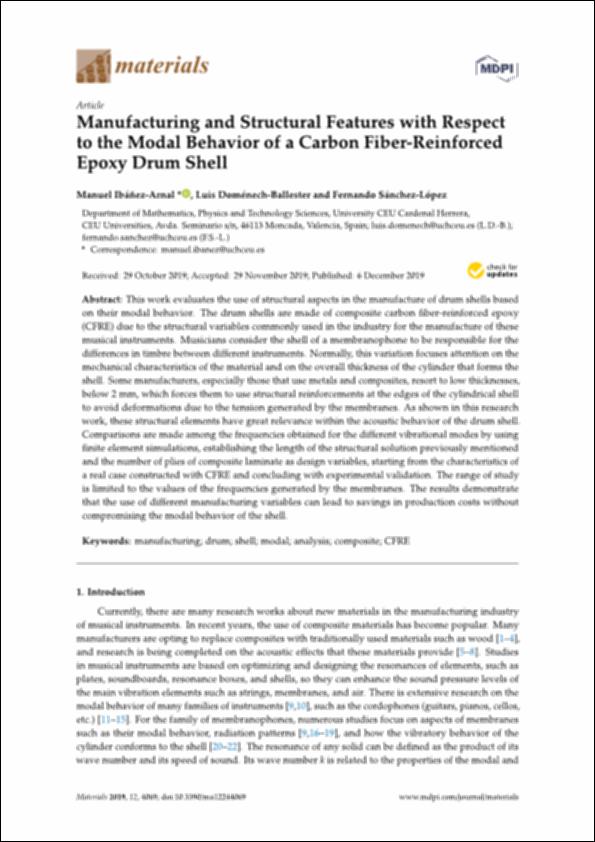Por favor, use este identificador para citar o enlazar este ítem:
http://hdl.handle.net/10637/10868Manufacturing and structural features with respect to the modal behavior of a carbon fiber-reinforced epoxy drum shell
| Título : | Manufacturing and structural features with respect to the modal behavior of a carbon fiber-reinforced epoxy drum shell |
| Autor : | Ibáñez Arnal, Manuel Doménech Ballester, Luis Sánchez López, Fernando |
| Materias: | Drums - Design and construction.; Percussion instruments - Design and construction.; Tambores - Diseño y fabricación.; Instrumentos de percusión - Diseño y fabricación.; Música - Acústica y física.; Music - Acoustic and physics.; Tambores - Materiales.; Drums - Materials. |
| Editorial : | MDPI. |
| Citación : | Ibáñez-Arnal, M., Doménech-Ballester, L. & Sánchez-López, F. (2019). Manufacturing and structural features with respect to the modal behavior of a carbon fiber-reinforced epoxy drum shell. Materials, vol. 12, n. 24, art. 4069 (6 dec.). DOI: https://doi.org/10.3390/ma12244069 |
| Resumen : | This work evaluates the use of structural aspects in the manufacture of drum shells based on their modal behavior. The drum shells are made of composite carbon fiber-reinforced epoxy (CFRE) due to the structural variables commonly used in the industry for the manufacture of these musical instruments. Musicians consider the shell of a membranophone to be responsible for the diferences in timbre between di erent instruments. Normally, this variation focuses attention on the mechanical characteristics of the material and on the overall thickness of the cylinder that forms the shell. Some manufacturers, especially those that use metals and composites, resort to low thicknesses, below 2 mm, which forces them to use structural reinforcements at the edges of the cylindrical shell to avoid deformations due to the tension generated by the membranes. As shown in this research work, these structural elements have great relevance within the acoustic behavior of the drum shell. Comparisons are made among the frequencies obtained for the di erent vibrational modes by using finite element simulations, establishing the length of the structural solution previously mentioned and the number of plies of composite laminate as design variables, starting from the characteristics of a real case constructed with CFRE and concluding with experimental validation. The range of study is limited to the values of the frequencies generated by the membranes. The results demonstrate that the use of di erent manufacturing variables can lead to savings in production costs without compromising the modal behavior of the shell. |
| Descripción : | Este es el artículo que se ha publicado de forma definitiva en: https://www.mdpi.com/1996-1944/12/24/4069 Este artículo pertenece a la sección "Structure Analysis and Characterization". |
| URI : | http://hdl.handle.net/10637/10868 |
| Derechos: | http://creativecommons.org/licenses/by/4.0/deed.es |
| ISSN : | 1996-1944 (Electrónico). |
| Fecha de publicación : | 6-dic-2019 |
| Centro : | Universidad Cardenal Herrera-CEU |
| Aparece en las colecciones: | Dpto. Matemáticas, Física y Ciencias Tecnológicas |
Los ítems de DSpace están protegidos por copyright, con todos los derechos reservados, a menos que se indique lo contrario.


